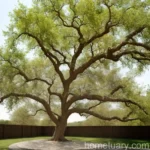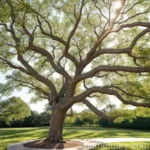The Fascinating World of Swamp White Oak (Quercus bicolor)
As a plant scientist, I am thrilled to explore the captivating characteristics, uses, and cultivation requirements of the swamp white oak (Quercus bicolor). This remarkable species is not only an essential component of various ecosystems but also holds significant cultural, ecological, and aesthetic value. Join me on this enlightening journey as we delve into the intricacies of this majestic tree.
What is Plant: Swamp White Oak (Quercus bicolor)
The swamp white oak, scientifically known as Quercus bicolor, is a species of oak native to eastern and central North America. It belongs to the family Fagaceae, which also includes beeches and chestnuts. This deciduous tree is renowned for its distinctive bi-colored leaves, with the upper surface being dark green and the lower surface covered in a silvery-white tomentum, giving it a striking appearance.
Key Takeaways – Swamp White Oak (Quercus bicolor)
Before we embark on our exploration of the swamp white oak, let’s highlight the key takeaways that will guide us through this comprehensive discussion:
- Characteristics: The unique characteristics of Quercus bicolor.
- Habitat and Distribution: Information about the natural habitat and geographical distribution of swamp white oak.
- Cultural and Ecological Importance: The ecological and cultural significance of the species.
- Cultivation and Care: Guidelines for planting, watering, sunlight requirements, and soil preferences.
- Uses: The diverse applications and benefits of swamp white oak.
- Diseases and Pests: Common diseases and pests that affect Quercus bicolor.
Now, let’s embark on our journey to unravel the enchanting world of the swamp white oak.
Characteristics of Quercus bicolor
Swamp White Oak Tree
The swamp white oak is a medium to large-sized deciduous tree, typically reaching heights of 60 to 70 feet. It is recognized for its broad, rounded crown and sturdy, spreading branches. The trunk of the swamp white oak is often short and stout, contributing to its robust and majestic appearance. The species is also known for its dense, fibrous roots that aid in its adaptation to wetland habitats.
Quercus bicolor Leaves
A defining feature of the swamp white oak is its unique foliage. The leaves of Quercus bicolor are alternate, simple, and lobed, with a distinctive bi-colored appearance. The upper surface of the leaf is a lustrous dark green, while the lower surface is covered in a dense layer of silvery-white tomentum, which offers a visually striking contrast. The leaves turn a beautiful yellow or yellow-brown in the fall, adding to the tree’s aesthetic appeal.
Swamp White Oak Habitat
Swamp white oak thrives in a diverse range of habitats, often found in low-lying areas such as swamps, floodplains, and along riverbanks. It exhibits a remarkable tolerance for wet soils, making it well-suited for environments with periodic flooding or high moisture levels. The species is also adaptable to a variety of soil types, including clay, loam, and sand, further enhancing its ecological versatility.
Quercus bicolor Growth
The growth pattern of swamp white oak is moderately fast, particularly in its early years. As the tree matures, its growth rate tends to slow down, culminating in a sturdy and enduring specimen. The species exhibits a well-developed root system, which aids in anchoring it firmly in its habitat and allows for efficient nutrient and water uptake.
Swamp White Oak Features
Apart from its bi-colored leaves, the swamp white oak boasts an array of notable features. Its acorns, which serve as a vital food source for wildlife, are large and provide sustenance for various mammals and birds. The bark of Quercus bicolor is grayish-brown, with deep furrows and ridges that add texture and visual interest to the tree’s exterior.
Cultivation and Care of Swamp White Oak
Water
The swamp white oak, as the name suggests, exhibits a remarkable affinity for moist or wet soils, making it an ideal candidate for planting in areas prone to seasonal inundation. However, once established, the tree demonstrates good drought tolerance, although regular watering is beneficial, especially during prolonged dry spells. When cultivating swamp white oak in a garden or landscape setting, it is crucial to ensure adequate moisture, particularly during the establishment phase.
Sunlight
Swamp white oak thrives in a variety of light conditions, including full sun to partial shade. In warmer regions, it benefits from some protection from the intense midday sun, while in cooler climates, it can tolerate more sunlight exposure. The adaptability of Quercus bicolor to different light levels makes it a versatile and resilient species suitable for diverse environmental settings.
Fertilizer
When it comes to fertilization, swamp white oak generally thrives in nutrient-rich soils without the need for excessive supplementation. In natural settings, the tree obtains essential nutrients from the decomposition of leaf litter and organic matter. However, in urban or cultivated environments where soil quality may be compromised, the application of a balanced, slow-release fertilizer can promote healthy growth and vigor.
Soil
The swamp white oak exhibits a wide tolerance for various soil types, including moist, loamy, and well-drained soils. While it is most commonly associated with wetland areas, the species can adapt to drier soils once established. It is essential to ensure adequate drainage, particularly in compacted or poorly draining soils, to prevent waterlogging and root rot. Maintaining a slightly acidic to neutral soil pH is beneficial for optimal growth and nutrient uptake.
Pruning
Pruning requirements for swamp white oak are minimal, particularly in natural or woodland settings. In urban landscapes or gardens, light pruning may be necessary to remove dead or damaged branches, maintain a balanced canopy, and promote airflow. It is crucial to adhere to best pruning practices to minimize stress and potential disease susceptibility. Pruning should ideally be carried out during the dormant season to minimize sap loss and optimize wound healing.
Propagation
Propagating swamp white oak can be achieved through seeds or vegetative methods such as hardwood cuttings or grafting. When collecting acorns for propagation, it is essential to select mature, healthy seeds from reliable sources. Stratifying the seeds—subjecting them to a period of cold, moist conditions—can enhance germination rates. Vegetative propagation methods are typically employed for selected cultivars or to preserve specific genetic traits.
Container Popularity
While swamp white oak is primarily appreciated for its role in native landscapes and naturalized settings, it can also thrive in large containers if provided with adequate space and growing conditions. Container-grown specimens offer opportunities for urban environments, patios, and outdoor spaces where the species’ ornamental and ecological value can be appreciated.
Uses of Swamp White Oak
Ecological Importance
From an ecological standpoint, the swamp white oak plays a pivotal role in its native habitat. Its status as a wetland species contributes to stabilizing soil, enhancing water quality, and providing valuable habitat for diverse wildlife. The tree’s acorns serve as a vital food source for numerous species, including deer, squirrels, waterfowl, and various birds, thus supporting the intricate web of life within wetland ecosystems.
Cultural Significance
The cultural significance of swamp white oak extends beyond its ecological contributions. Historically, the timber of Quercus bicolor has been valued for its strength, durability, and attractive grain patterns, making it a sought-after material for woodworking, furniture construction, and decorative applications. The species also holds symbolic value in indigenous cultures and has been used in traditional medicine, crafts, and ceremonies.
Landscape and Design
From a landscaping perspective, swamp white oak is prized for its aesthetic appeal and adaptability to diverse soil and moisture conditions. It is often used in naturalistic plantings, wetland restoration projects, and alongside water features, where its striking foliage, sturdy structure, and ecological attributes are showcased. The species’ autumn colors and textured bark further enhance its value in landscape design.
Common Diseases and Pests of Quercus bicolor
Disease Diagnosis
While swamp white oak is generally resilient and resistant to many pests and diseases, it can be susceptible to certain ailments under unfavorable growing conditions. Common diseases that may affect Quercus bicolor include oak wilt, anthracnose, powdery mildew, and root rot. Timely diagnosis and appropriate management strategies are critical in mitigating the impact of these diseases and maintaining the tree’s health.
Common Pests
In terms of pests, swamp white oak may encounter challenges such as oak leaf roller, scale insects, spider mites, and caterpillars. Regular monitoring of the tree’s foliage, especially during the growing season, can aid in early pest detection and intervention. Cultural practices that promote tree vigor, such as proper watering, mulching, and maintenance of overall plant health, can mitigate pest pressures.
Botanist’s Tips for Growing Swamp White Oak
- Selecting a Planting Site: When choosing a location for swamp white oak, prioritize well-drained, moist soils with occasional flooding tolerance.
- Watering: During the establishment phase, ensure consistent soil moisture, gradually reducing water frequency as the tree matures.
- Soil pH: Maintain a slightly acidic to neutral soil pH to support nutrient availability and root health.
- Pruning: Practice minimal pruning, focusing on corrective or maintenance pruning to preserve the tree’s natural form.
- Mulching: Apply a layer of organic mulch around the base of the tree to conserve soil moisture and suppress weed growth.
- Pest and Disease Management: Regularly inspect the tree for signs of pests and diseases, and implement integrated pest management strategies if necessary.
Fun Facts about Swamp White Oak
To further appreciate the captivating qualities of Quercus bicolor, let’s explore some fascinating and enlightening fun facts:
- The acorns of swamp white oak are a valuable food source for wildlife, contributing to the ecological diversity of its habitat.
- The distinctive bi-colored leaves of Quercus bicolor make it an eye-catching feature in naturalized landscapes and wetland environments.
- Swamp white oak demonstrates remarkable adaptability to wet soils, showcasing its resilience and ecological versatility.
- The beautiful autumn colors of the tree, ranging from yellow to brown, add a striking visual element to the landscape during the fall season.
- The timber of Quercus bicolor is prized for its strength and attractive grain patterns, making it a preferred material for woodworking and construction.
As we continue to unravel the complexities and virtues of the swamp white oak, it becomes increasingly evident that this species holds immense ecological, cultural, and aesthetic value.
Links to External Resources
To further enrich your understanding of swamp white oak and explore additional insights, I recommend delving into the following external resources:
- USDA Plant Guide: Swamp White Oak
- Lady Bird Johnson Wildflower Center: Quercus bicolor
- Illinois Wildflowers: Quercus bicolor
- Missouri Botanical Garden: Quercus bicolor
- US Forest Service: Silvics of North America – Quercus Bicolor
By exploring these resources, you can gain in-depth knowledge of swamp white oak, its ecological role, and best practices for its cultivation and conservation.
In conclusion, the swamp white oak (Quercus bicolor) stands as a testament to the remarkable diversity and resilience of our natural world. Its captivating features, ecological importance, and cultural significance make it a tree of unparalleled value—worthy of admiration, preservation, and thoughtful integration into our landscapes and ecosystems. I hope this exploration has kindled a deeper appreciation for the enchanting world of swamp white oak, inviting us to marvel at the intricate tapestry of life that it embodies.
Remember, it’s not just a tree—it’s a living legacy, a symbol of strength, and a testament to the enduring beauty of nature.

Image: Swamp White Oak (Quercus bicolor).
Word Count: 1500












